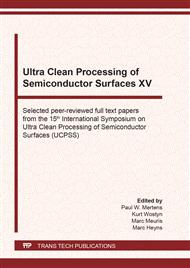[1]
P. G. Pape, 29-Adhesion Promotors: Silane Coupling Agents: Applied Plastics Engineering Handbook, M. Kutz Ed. (William Andrew Publishing, Oxford, 2011), 503-517.
Google Scholar
[2]
F. Goethals, M. R. Baklanov, I. Ciofi, C. Detavernier, P. Van Der Voort, I. Van Driessche, A New Procedure to Seal the Pores of Mesoporous Low-K Films with Precondensed Organosilica Oligomers, Chem. Comm. 48(22) (2012), 2797-2799.
DOI: 10.1039/c2cc18017k
Google Scholar
[3]
A. J. Muscat, Self-Assembly of Functionalized Organic Molecules on Flat Solid Surfaces, Encyclopedia of Interfacial Chemistry 4 (2018), 810-816.
DOI: 10.1016/b978-0-12-409547-2.13137-3
Google Scholar
[4]
See for example the Gelest catalog at https://www.gelest.com/product-lines/silanes/.
Google Scholar
[5]
A.N. Parikh, D.L. Allara, I.B. Azouz, F. Rondelez, An Intrinsic Relationship Between Molecular Structure in Self-Assembled n-Alkoxysilane Monolayers and Deposition Temperature, J. Phys. Chem. 98 (1994), 7577–7590.
DOI: 10.1021/j100082a031
Google Scholar
[6]
H. Jalali, B. D. Gates, Monitoring and Mapping Imperfections in Silane-Based Self-Assembled Monolayers by Chemical Amplification, Langmuir 25 (2009), 9078–9084.
DOI: 10.1021/la900443c
Google Scholar
[7]
R. Wojtecki, M. Mettry, N. F. Fine Nathel, A. Friz, A. De Silva, N. Arellano, H. Shobha, Fifteen Nanometer Resolved Patterns in Selective Area Atomic Layer Deposition-Defectivity Reduction by Monolayer Design, ACS Appl. Mater. Interfaces 10 (2018), 38630–38637.
DOI: 10.1021/acsami.8b13896
Google Scholar
[8]
R. Maoz, J. Sagiv, On the Formation and Structure of Self-assembling Monolayers. I. J. Colloid Interface Sci. 100 (1984), 465–496.
DOI: 10.1016/0021-9797(84)90452-1
Google Scholar
[9]
K. Wen, R. Maoz, H. Cohen, J. Sagiv, A. Gibaud, A. Desert, B. M. Ocko, Postassembly Chemical Modification of a Highly Ordered Organosilane Multilayer, ACS Nano 2 (2008), 579–599.
DOI: 10.1021/nn800011t
Google Scholar
[10]
J. Hong, D.W. Porter, R. Sreenivasan, P.C. McIntyre, S.F. Bent, ALD Resist Formed by Vapor-Deposited Self-Assembled Monolayers, Langmuir 23 (2007), 1160– 1165.
DOI: 10.1021/la0606401
Google Scholar
[11]
J.B. Brzoska, I.B. Azouz, F. Rondelez, Silanization of Solid Substrates: A Step Toward Reproducibility, Langmuir 10(11) (1994), 4367-4373.
DOI: 10.1021/la00023a072
Google Scholar
[12]
M. Reinke, Y. Kuzminykh, P. Hoffmann, Selective Growth of Titanium Dioxide by Low-Temperature Chemical Vapor Deposition, ACS Appl. Mater. Interfaces 7(18) (2015), 9736-9743.
DOI: 10.1021/acsami.5b01561
Google Scholar
[13]
A.Y. Fadeev, T.J. McCarthy, Self-Assembly Is Not the Only Reaction Possible between Alkyltrichlorosilanes and Surfaces: Monomolecular and Oligomeric Covalently Attached Layers of Dichloro-and Trichloroalkylsilanes on Silicon, Langmuir 16(18)(2000), 7268-7274.
DOI: 10.1021/la000471z
Google Scholar
[14]
A.P. Hinckley, A.J. Muscat, Detecting and Removing Defects in Organosilane Self-Assembled Monolayers, Langmuir 36(10) (2020), 2563-2573.
DOI: 10.1021/acs.langmuir.9b02753
Google Scholar
[15]
R.D. Peters, P. F. Nealey, J. N. Crain, F. J. Himpsel, A Near Edge X-ray Absorption Fine Structure Spectroscopy Investigation of the Structure of Self-Assembled Films of Octadecyltrichlorosilane, Langmuir 18(4) (2002), 1250–1256.
DOI: 10.1021/la011198j
Google Scholar


